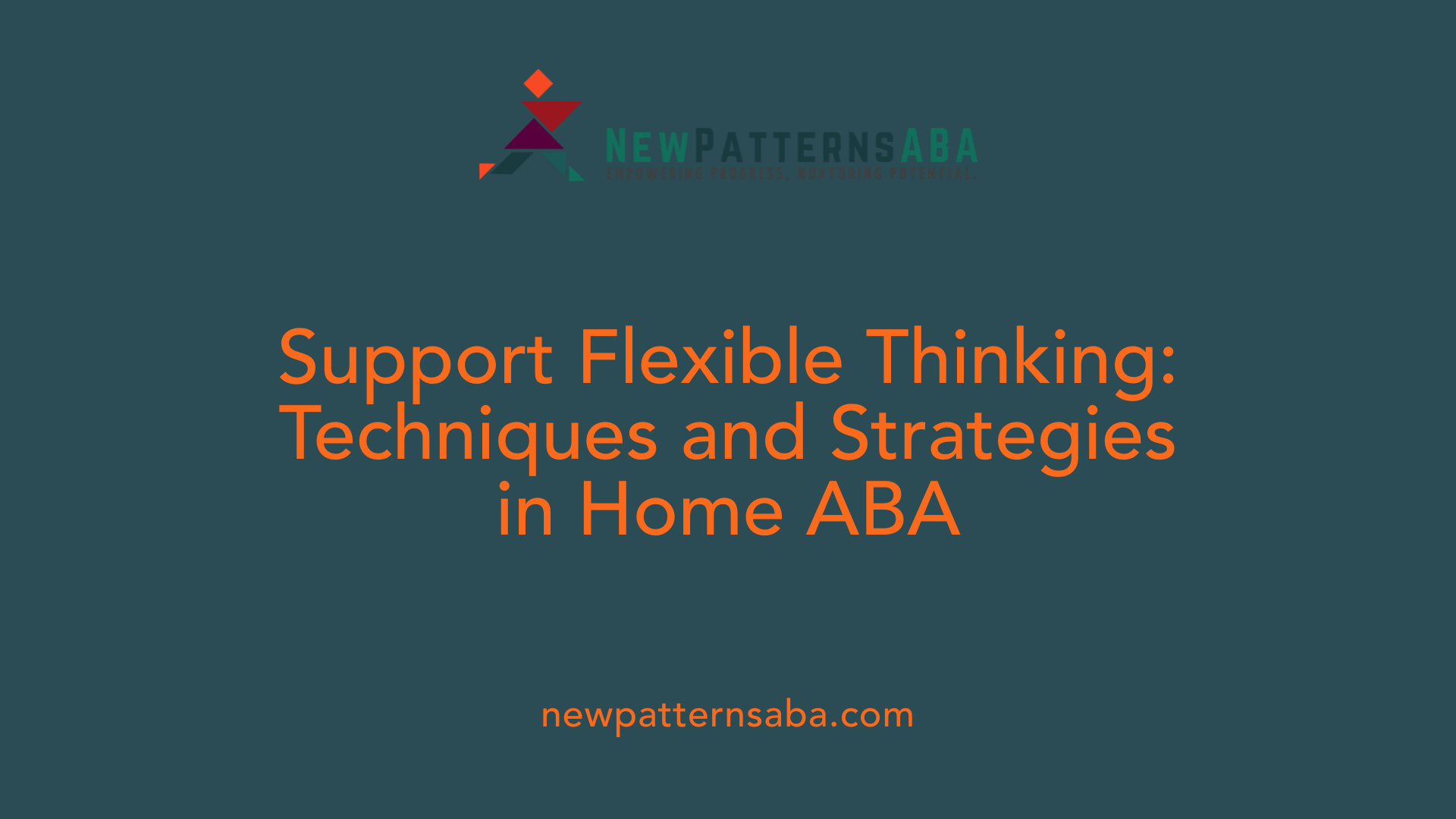Understanding the Role of Home-Based ABA in Developing Flexible Thinking
Home-based Applied Behavior Analysis (ABA) therapy has emerged as a highly effective approach for teaching children with autism crucial life skills, including flexible thinking. Recognized globally for its evidence-based techniques, ABA's personalization and naturalistic setting enable children to generalize skills across environments, particularly within the comfort of their homes. This article explores how home-based ABA therapy not only fosters foundational skills but also cultivates adaptability and resilience, empowering children to navigate an ever-changing world effectively.
Personalized Interventions within Familiar Settings

What are the benefits of home-based ABA therapy for children with autism?
Home-based ABA therapy creates a tailored and comforting setting that significantly benefits children on the autism spectrum. When therapy takes place in the familiar environment of their home, children often feel more relaxed and secure, which can lead to increased engagement and reduced anxiety.
This setting allows therapists to design highly individualized interventions that align with each child's routines and daily activities. For example, activities can be seamlessly integrated into mealtime, play, or other familiar routines, making learning more relevant and effective. Moreover, practicing skills in the home environment supports better generalization, meaning children are more likely to apply what they learn across different settings, including school and community.
Family involvement is a core aspect of home-based ABA. Parents and caregivers receive hands-on training from therapists, equipping them with strategies to reinforce skills and behaviors consistently. This active participation enhances the therapy's effectiveness by ensuring that skills are practiced regularly and integrated into daily life.
Research shows that children receiving home-based ABA often demonstrate notable improvements in communication, social skills, self-care, and academic abilities. Additionally, therapy in the home reduces stress, minimizes exposure to illnesses, and removes barriers like travel, making consistent therapy sessions more feasible and comfortable for both children and families.
In summary, the personalized approach and natural environment of home-based ABA therapy support meaningful progress, fostering a sense of safety, routine, and real-world application that is crucial for long-term success.
The Significance of Family Involvement
What role does family involvement play in the success of ABA therapy?
Family participation is crucial in making ABA therapy effective. When parents and caregivers are actively involved, they can help reinforce behaviors learned during sessions and ensure consistency at home. This daily support helps children generalize new skills to different settings, which is essential for long-term progress.
Training and resources provided to families empower them to understand ABA principles and apply techniques such as positive reinforcement, prompting, and shaping correctly. When parents have the right tools and guidance, they can tailor interventions to suit their child's routine and needs.
Moreover, emotional support and nurturing parent-child relationships boost the child's motivation to participate actively in therapy. Open communication between families and therapists ensures that treatment plans stay flexible and responsive to progress or challenges.
Ultimately, family involvement enriches the therapy process, making it more personalized and effective, leading to better developmental outcomes for children with autism.
Behavioral Techniques and Strategies in Home ABA

How does home-based ABA therapy support the development of flexible thinking skills?
Home-based ABA therapy plays a significant role in fostering flexible thinking by utilizing a variety of strategies that challenge children to adapt and problem-solve in real-life settings. These approaches help children learn to manage change, unexpected situations, and new challenges.
One common technique involves modifying routines and introducing new activities, which encourages children to become comfortable with change. For example, therapists might alter the sequence of activities or use games with elements of chance, such as dice or card games, to simulate unpredictable outcomes. These activities teach children to approach surprises calmly and thoughtfully.
Incorporating brainstorming and pre-teaching helps children anticipate upcoming changes, reducing anxiety and increasing their readiness to adapt. This practice involves discussing potential changes beforehand, mentally preparing the child for what’s to come.
Furthermore, therapies often include principles borrowed from Acceptance and Commitment Therapy (ACT), emphasizing mindfulness and values-driven actions. These promote psychological flexibility, helping children accept their thoughts and feelings while engaging in adaptive behaviors.
Parents and caregivers are active participants in this process. Through modeling flexibility and practicing these strategies at home, they reinforce children’s ability to handle change. This comprehensive, naturalistic approach strengthens children’s resilience and adaptability in their daily lives.
Overall, home ABA therapy’s tailored interventions, consistent practice, and involvement of the family create an environment that nurtures flexible thinking skills, essential for navigating the complexities of everyday life.
Generalization and Retention of Skills
How Does ABA Help in Transferring Skills Across Different Environments?
One of the significant benefits of home-based ABA therapy is its ability to facilitate the transfer of learned skills across various settings. Since therapy occurs in the child's natural home environment, children become comfortable and familiar with the routines and surroundings. This familiarity helps them to apply their newly acquired skills, such as communication and self-care, in real-life situations beyond therapy sessions.
Using ABA techniques like naturalistic teaching methods, prompts, and reinforcement, therapists focus on teaching skills in contextually relevant ways. When these skills are practiced routinely at home, children often generalize them more easily to other environments like school, outings, or community activities. This process leads to improved independence and confidence, as children can utilize their skills effectively in everyday life.
Why Is Consistent Practice Essential for Skill Retention?
Consistent practice is vital for solidifying learning and ensuring that skills are maintained over time. Home-based ABA therapy encourages regular and structured use of targeted skills, which helps embed them into the child's routine. As parents and caregivers are involved in the therapy process, they learn how to reinforce skills daily, creating a supportive environment that promotes ongoing development.
Research supports that children who engage in consistent practice at home demonstrate better retention of skills and quicker progress. Moreover, ongoing monitoring through data collection allows therapists to make data-driven adjustments, reinforcing the importance of routine and consistency.
How Do These Elements Support Long-Term Success?
The combination of skill transfer across settings and continuous practice leads to meaningful, lasting improvements. Children not only learn new behaviors but also retain them longer, giving them more opportunities for independence. Families play a crucial role, as their involvement ensures that the therapy's benefits extend beyond the sessions.
In summary, home-based ABA therapy's emphasis on natural settings and regular practice provides a foundation for children to retain and generalize essential life skills effectively. This approach ultimately helps children lead more independent, confident lives by applying what they've learned in their daily routines.
Benefits of Learning in a Stress-Reduced Environment
How does reducing anxiety and stress benefit children during ABA therapy?
Creating a calm and familiar environment is fundamental in home-based ABA therapy. When children are in a setting where they feel safe and secure, they tend to be more engaged and willing to participate in learning activities. Reduced anxiety levels help children focus better on their tasks, which can lead to more effective skill acquisition and behavior change.
A familiar space alleviates the discomfort often associated with unfamiliar environments, making therapy sessions less intimidating. This comfort layer encourages children to try new skills without fear of unfamiliar stimuli, supporting more consistent progress.
Children with autism often experience sensory sensitivities and stress, which can interfere with therapy outcomes. The home environment allows for tailored modifications—such as adjusting lighting, noise levels, and activity timing—to suit each child's needs.
What are the benefits of familiar surroundings?
Familiar surroundings like home enable children to practice skills in real-world contexts, facilitating better generalization across settings. Skills learned in a natural environment are more likely to be retained and used in daily life.
In addition, home-based therapy promotes consistency, as children can integrate new behaviors during routines they already participate in—like mealtime, bedtime, or play. This seamless incorporation enhances learning, making it more meaningful and sustainable.
Family involvement is central in such setups. Caregivers learn strategies from therapists, which they can apply during everyday activities, reinforcing progress and building a cohesive learning experience.
Overall, a stress-reduced, familiar setting supports not only the emotional well-being of children but also their developmental growth, making ABA therapy more effective and enjoyable.
Structured Routine and Its Impact on Learning

Creating effective ABA routines
Developing a successful home-based ABA routine begins with understanding the child's unique needs and interests. Incorporating activities the child enjoys helps boost motivation and engagement. Establishing clear, consistent schedules allows children to learn in a predictable environment, which is essential for reducing anxiety and promoting steady progress. Techniques such as prompting, modeling, and positive reinforcement can be integrated into daily routines to reinforce desired behaviors.
Consistent practice within a structured environment ensures that children experience continuous learning opportunities. Using naturalistic teaching methods during daily activities — like mealtime, play, or chores — makes the therapy relevant and effective. Flexibility within routines allows adjustments based on progress and specific goals.
Assessing individual needs and goals
The first step in establishing a home-based ABA routine involves thorough assessment of the child's current skills, interests, and challenges. Collaborating with therapists and family members helps set realistic, personalized goals that target communication, social skills, or self-care, among other areas.
Regular assessment ensures the routine adapts to the child's evolving needs. Data collection and progress monitoring are critical for making informed adjustments. By tailoring the schedule to the child's strengths and areas for growth, caregivers can maximize learning opportunities and foster meaningful development.
Establishing a home-based ABA routine involves assessing the child's needs, setting clear goals, and creating a structured schedule.
Implementing ABA techniques at home involves creating a structured, supportive environment and working closely with professionals to maximize benefits. This collaboration enhances the child's success by ensuring consistency and reinforcing skills across settings.
Monitoring Progress and Adjusting Strategies
How is data collection and analysis used in ABA?
In home-based ABA therapy, meticulous data collection is fundamental. Therapists and caregivers track specific behaviors, recording how often they occur, their intensity, and the context in which they happen. This information provides a clear picture of a child's progress over time.
Regular analysis of this data helps identify trends and assess whether interventions are effective. For instance, an increase in positive behaviors or communication skills indicates successful strategies. On the other hand, if data shows little or no improvement, techniques can be revised promptly.
How are interventions tailored based on progress?
Adjusting ABA strategies based on ongoing data ensures that therapy remains effective and personalized. If a particular prompt or reinforcement doesn't yield desired results, caregivers and therapists modify their approach, perhaps by changing the type or timing of reinforcement or introducing new teaching methods.
This adaptability allows for the continuous refinement of interventions, making therapy more relevant to the child's evolving needs. Regular progress monitoring fosters a dynamic treatment plan that can respond promptly to the child's development, increasing the likelihood of meaningful skill acquisition.
How do ABA techniques like prompts, modeling, and positive reinforcement fit into progress monitoring?
Effective ABA techniques such as prompts, modeling, and positive reinforcement are central to behavior change. Monitoring how well these techniques work involves tracking the child's responses during sessions. For example, if a prompt consistently leads to a desired behavior, it can be reinforced further or made more natural.
Revisions are made based on data collected, ensuring that strategies are tailored to what motivates and effectively engages the child. This ongoing cycle of data collection, analysis, and adjustment helps in optimizing the therapy process.
Resources for monitoring ABA progress at home
Parents and caregivers can utilize various tools like charts, apps, or online platforms to facilitate data collection. Support groups and online courses also provide guidance on analyzing data and adjusting strategies effectively.
Consistent monitoring and flexible adjustment of interventions are essential for maximizing the benefits of home-based ABA therapy, helping children achieve their developmental goals.
Leveraging Resources for Successful Therapy
 Support groups, online tools, and qualified therapists are essential for maximizing the benefits of home-based ABA therapy. Qualified therapists provide personalized guidance, ensuring interventions are effective and tailored to the child's needs. Online tools help parents and caregivers track progress, access therapy resources, and stay informed about best practices.
Support groups, online tools, and qualified therapists are essential for maximizing the benefits of home-based ABA therapy. Qualified therapists provide personalized guidance, ensuring interventions are effective and tailored to the child's needs. Online tools help parents and caregivers track progress, access therapy resources, and stay informed about best practices.
Support groups connect families with others undergoing similar experiences, offering emotional support and practical advice. These communities can boost confidence and motivation, reinforcing the commitment to therapy.
Utilizing these resources creates a comprehensive support system that enhances consistency and outcomes. Regular consultation with professionals ensures that interventions remain aligned with the child's evolving needs. Online platforms can also offer training modules for caregivers, promoting effective reinforcement of skills at home.
In addition, evolving technologies such as apps and virtual coaching make therapy more accessible and flexible, fitting seamlessly into daily routines. Combining expert guidance, digital tools, and community support provides a robust foundation for success in home-based ABA therapy.
Enhancing Engagement through Play and Interests

How does incorporating a child's interests make therapy sessions more effective?
Integrating a child's personal interests into ABA therapy sessions within the home environment significantly boosts engagement and motivation. When therapy aligns with what a child naturally enjoys or is curious about, they tend to participate more actively and with enthusiasm.
For example, if a child loves animals, therapists and parents can incorporate animal-themed activities and toys into learning tasks. This tailored approach not only makes the session more fun but also enhances learning outcomes.
Making learning appealing and motivating
Making learning appealing in a familiar, safe setting helps children feel more comfortable and less anxious. This increased comfort can lead to better focus, greater willingness to participate, and more consistent practice of new skills.
Incorporating interests ensures that therapy feels less like a chore and more like a game or exploration, which is crucial for children with autism. Motivated children are more likely to stay engaged, leading to better skill acquisition and generalization.
Using a child's interests as part of ABA strategies aligns with the principle of naturalistic teaching methods, where skills are taught in real-life contexts, making the learning process seamless and effective. Parental involvement in selecting and integrating these interests can further enhance the child's progress, ensuring that therapy is both purposeful and enjoyable.
Research shows that personalized, interest-based activities in home ABA therapy lead to improved participation and more meaningful learning experiences, helping children develop essential skills in a motivating way.
Maximizing Development through Personalized, Home-Based Approaches
Home-based ABA therapy stands out as a comprehensive, adaptable, and family-centered approach that significantly advances flexible thinking and everyday functioning in children with autism. Its natural environment, tailored interventions, active family involvement, and focus on continuous progress make it an invaluable resource for fostering resilience and independence. By integrating ABA strategies into daily routines, parents and caregivers become vital partners in their child's growth, ensuring that learned skills are maintained, generalized, and applied across all areas of life. As research and clinical practices continue to evolve, home-based ABA remains a powerful tool in unlocking a child's full potential.
References
- Effectiveness of Home-Based ABA Therapy for Children with Autism
- Implementing In-Home ABA Therapy
- Establishing a Home-Based ABA Therapy Routine for Early ...
- Home-Based ABA Therapy Programs in Georgia
- The Role of Caregiver Involvement in ABA Therapy
- Helping Parents Understand Applied Behavior Analysis: Creating a ...
- The Role of Family in ABA Therapy: Tips for Parents
- Impact of ABA Therapy: The Key Role of Parental Involvement





